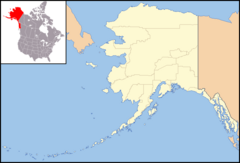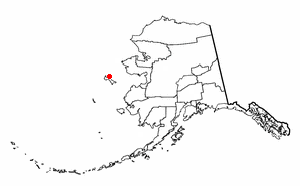St. Lawrence Island
 Closeup map of St. Lawrence Island | |
| Geography | |
|---|---|
| Location | Bering Sea |
| Coordinates | Coordinates: |
| Area | 1,791.56 square miles (4,640.1 km²) |
| Length | 90 miles (140 km) |
| Width | 22 miles (35 km) |
| Country | |
| {{country data United States
| country flag2 | countryname = United States | variant = | size = | name = United States }} | |
| State | |
| Largest city | Gambell (653) |
| Demographics | |
| Population | 1292 (as of 2000) |
| Density | 0.28 people/km2 |
St. Lawrence Island is located west of mainland Alaska in the Bering Sea, just south of the Bering Strait, at about 64° North 170° 1928' West. It is part of Alaska, but closer to Russia than to the Alaskan mainland. St. Lawrence Island is thought to be one of the last surviving non-submerged portions of the land bridge that once joined Asia with North America during the Pleistocene period.[1] It is the sixth largest island in the United States and the 113th largest island in the world.
Geography
The United States Census Bureau defines St. Lawrence Island as Block Group 6, Census Tract 1 of Nome Census Area, Alaska. As of the 2000 census there were 1,292 people living on a land area of 4,640.12 km² (1,791.56 sq mi).[2] The island is about 145 km (90 miles) long and 13–36 km (8–22 miles) wide. The island has no trees, and the only woody plants are Arctic Willow, standing no more than a foot (30 cm) high.
The island's abundance of seabirds and marine mammals is due largely to the influence of the Anadyr Current, an ocean current which brings cold, nutrient-rich water from the deep waters of the Bering Sea shelf edge.
To the south of the island is a persistent polynya, formed when the prevailing winds from the north and east blow the migrating ice away from the coast.[3]
Prehistory
http://www.accessmylibrary.com/coms2/summary_0286-27354107_ITM
St. Lawrence Island was first occupied around 2,000 to 2,500 years ago by coastal people characterized by artifacts decorated in the Okvik (oogfik) style. Archaeological sites on the Punuk Islands, off the eastern end of St. Lawrence Island, at Kukulik, near Savoonga and on the hill slopes above Gambell have evidence of the Okivik occupation. The Okvik decorative style is zoomorphic and elaborate, executed in a sometimes crude engraving technique, with greater variation than the later Old Bering Sea and Punuk styles.
The Okivik occupation is influenced by and may have been coincident with the Old Bering Sea occupation of 2000 years ago to around 700 years ago, characterized by the simpler and more homogeneous Punuk style. Stone artifacts changed from chipped stone to ground slate; carved ivory harpoon heads are smaller and simpler in design.
Prehistoric and early historic occupations of St. Lawrence Island were never permanent, with periods of abandonment and reoccupation depending on resource availability and changes in weather patterns. Famine was common, as evidenced by Harris lines and enamel hypoplasia in human skeletons. Travel to and from the mainland was common during calm weather, so the island was used as a hunting base, and occupation sites were re-used periodically rather than permanently occupied.
Major archaeology sites at Gambell and Savoonga (Kukulik) were excavated by Otto Geist and Ivar Skarland of the University of Alaska Fairbanks. Collections from these excavations are curated at the University of Alaska Museum on the UAF campus.
History
The island was called Sivuqaq by the Yupik who lived there. It was visited by Russian/Danish explorer Vitus Bering on St. Lawrence's Day, August 10 (Old Style), 1728, and named after the day of his visit. The island was the first place in Alaska known to have been visited by European explorers.
There were about 4,000 Central Alaskan Yupik and Siberian Yupik living in several villages on the island in the mid 1800s. They subsisted by hunting walrus and whale and by fishing. A famine in 1878–1880 caused many to starve and many others to leave, decimating the island's population. Nearly all the residents remaining were Siberian Yupik.
Reindeer were introduced on the island in 1900 in an attempt to bolster the economy. The reindeer herd grew to about 10,000 animals by 1917, but has since declined. Reindeer are herded as a source of subsistence meat to this day.
Villages
The island presently contains two villages: Savoonga and Gambell. The two villages were given title to most of the land on St. Lawrence Island by the Alaska Native Claims Settlement Act in 1971. As a result of having title to the land, the Yupik are legally able to sell the fossilized ivory and other artifacts found on St. Lawrence Island.
The island is now inhabited mostly by Siberian Yupik engaged in hunting, fishing, and reindeer herding. The St. Lawrence Island Yupik people are also known for their skill in carving, mostly with materials from marine mammals (walrus ivory and whale bone).
Northeast Cape and PCB contamination
Northeast Cape Air Force Station (AFS) was a United States Air Force facility consisting of an Aircraft Control and Warning (AC&W) radar site, a United States Air Force Security Service (USAFSS) listening post and a White Alice Communications System (WACS) site constructed at Northeast Cape on St. Lawrence Island. It operated from about 1952 to about 1972. The area surrounding the Northeast Cape base site had been a traditional camp site for several Yupik families for centuries. After the base closed down in the 1970s, many of these people started to experience health problems. Even today, people who grew up at Northeast Cape have high rates of cancer and other diseases, possibly due to PCB exposure around the site.[4] According to the State of Alaska, those elevated cancer rates have been shown to be comparable to the rates of other Alaskan and non-Alaskan arctic natives who were not exposed to a similar Air Force facility.[5] In any event, the majority of the facility was removed in a $10.5 million dollar cleanup program in 2003. Monitoring of the site will continue into the future.[6]
Notes
- ↑ Tools and Implements: St. Lawrence Island and the Bering Strait Region. University of Missouri-Columbia Museum of Anthropology. Retrieved 2006-05-24.
- ↑ Block Group 6, Census Tract 1, Nome Census Area United States Census Bureau
- ↑ St Lawrence Polynya. Polar Research at UW Oceanography. Retrieved 2006-06-12.
- ↑ Coming Clean network. PCB's in People of St. Lawrence Island. Body Burden Report. Retrieved 2006-06-12.
- ↑ State of Alaska Epidemiology Bulletin. PCB Blood Test Results from St. Lawrence Island. February 6, 2003.
- ↑ State of Alaska Department of Environmental Conservation. St. Lawrence Island. Contaminated Sites Program. Retrieved 2006-06-12.
ReferencesISBN links support NWE through referral fees
- Collins, Henry B. 1937. Archaeology of St. Lawrence Island, Alaska. Washington, D.C.: Smithsonian Institution. OCLC 41798661
- Geist, Otto William, and Froelich G. Rainey. 1937. Archaeological excavations at Kukulik, St. Lawrence island, Alaska. Washington, D.C.: U.S. Govt. print. off. OCLC 2175223
- Hein, Tara. 2004. Tools and Implements: St. Lawrence Island and the Bering Strait Region University of Missouri. Retrieved January 29, 2009.
- State of Alaska Department of Environmental Conservation. Contaminated Sites Program, Saint Lawrence Island Retrieved January 29, 2009.
- Whitridge, P. 2000. "The Hillside Site, St. Lawrence Island, Alaska: An Examination of Collections from the 1930s, by Don E. Dumond". AMERICAN ANTIQUITY. 65: 774. OCLC 200858763
Credits
New World Encyclopedia writers and editors rewrote and completed the Wikipedia article in accordance with New World Encyclopedia standards. This article abides by terms of the Creative Commons CC-by-sa 3.0 License (CC-by-sa), which may be used and disseminated with proper attribution. Credit is due under the terms of this license that can reference both the New World Encyclopedia contributors and the selfless volunteer contributors of the Wikimedia Foundation. To cite this article click here for a list of acceptable citing formats.The history of earlier contributions by wikipedians is accessible to researchers here:
The history of this article since it was imported to New World Encyclopedia:
Note: Some restrictions may apply to use of individual images which are separately licensed.



